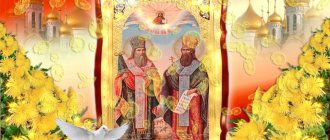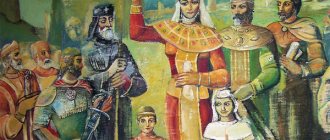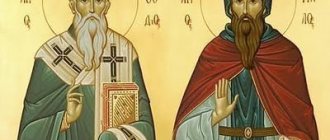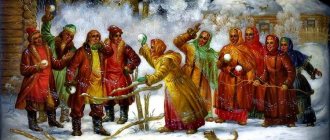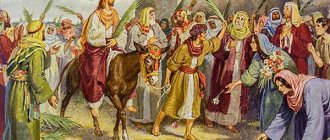Biography
Cyril and Methodius became famous throughout the world as champions of the Christian faith and authors of the Slavic alphabet. The biography of the couple is extensive; there is even a separate biography dedicated to Kirill, created immediately after the man’s death. However, today you can get acquainted with a brief history of the destinies of these preachers and founders of the alphabet in various manuals for children. The brothers have their own icon, where they are depicted together. People turn to her with prayers for good studies, luck for students, and increased intelligence.
Popular message topics
- Nabokov's works
Vladimir Vladimirovich Nabokov is a great writer, poet and translator who came from a Russian family. But, as the author said about himself, he is an American writer. - Ecological factors
Imagine any animal, just one separate from the whole species. And he was isolated from the whole world, left under the influence of the environment. The first factor in its survival will be whether the climate is suitable or unsuitable for it. - Lake of Russia
Who knows how many lakes there are in Russia? Probably no one will answer for sure. There is a figure and it is about 2 million lakes, which is impressive. It is possible to list only the largest and most famous lakes.
Childhood and youth
Cyril and Methodius were born in the Greek city of Thessaloniki (present-day Thessaloniki) in the family of a military leader named Leo, whom the authors of the biography of the couple of saints characterize as “of good birth and rich.” The future monks grew up in the company of five other brothers.
Cyril and Methodius meet with the Slavic people
Before tonsure, the men bore the names Mikhail and Konstantin, and the first was older - he was born in 815, and Konstantin in 827. Controversy still rages among historians about the ethnicity of the family. Some attribute him to the Slavs, because these people were fluent in the Slavic language. Others attribute Bulgarian and, of course, Greek roots.
The boys received an excellent education, and when they matured, their paths diverged. Methodius entered military service under the patronage of a faithful family friend and even rose to the rank of governor of a Byzantine province. During the “Slavic reign” he established himself as a wise and fair ruler.
ABC of Cyril and Methodius
From early childhood, Kirill was fond of reading books, amazed those around him with his excellent memory and abilities in science, and was known as a polyglot - in his linguistic arsenal, in addition to Greek and Slavic, there were Hebrew and Aramaic. At the age of 20, a young man, a graduate of Magnavra University, was already teaching the basics of philosophy at the court school at Constantinople.
Christian service
Kirill flatly refused a secular career, although such an opportunity was provided. Marriage to the goddaughter of an official of the royal chancellery in Byzantium opened up dizzying prospects - leadership of the region in Macedonia, and then the position of commander-in-chief of the army. However, the young theologian (Konstantin was only 15 years old) chose to take the church path.
Saints Cyril and Methodius. Miniature from the Radziwill Chronicle, 15th century
When he was already teaching at the university, the man even managed to win a theological debate over the leader of the iconoclasts, the former Patriarch John the Grammar, also known as Ammius. However, this story is considered simply a beautiful legend.
The main task for the Byzantine government at that time was considered to be the strengthening and promotion of Orthodoxy. Missionaries traveled along with the diplomats who traveled to cities and villages where they negotiated with religious enemies. This is what Konstantin became at the age of 24, setting off on his first important task from the state - to instruct Muslims on the true path.
Icon of Cyril and Methodius
At the end of the 50s of the 9th century, the brothers, tired of the bustle of the world, retired to a monastery, where 37-year-old Methodius took monastic vows. However, Cyril was not allowed to rest for a long time: already in 860, the man was called to the throne of the emperor and instructed to join the ranks of the Khazar mission.
The fact is that the Khazar Kagan announced an interreligious dispute, where Christians were asked to prove the truth of their faith to Jews and Muslims. The Khazars were already ready to go over to the side of Orthodoxy, but they set a condition - only if the Byzantine polemicists won the disputes.
Kirill took his brother with him and brilliantly completed the task assigned to him, but still the mission was a complete failure. The Khazar state did not become Christian, although the Kagan allowed people to be baptized. On this trip, a serious historical event happened for believers. Along the way, the Byzantines looked into Crimea, where, in the vicinity of Chersonesos, Cyril found the relics of Clement, the fourth holy Pope, which were then transferred to Rome.
The brothers are involved in another important mission. One day, the ruler of the Moravian lands (Slavic state) Rostislav asked for help from Constantinople - they needed teacher-theologians to tell the people about the true faith in an accessible language. Thus, the prince was going to escape the influence of the German bishops. This trip became significant - the Slavic alphabet appeared.
Cyril and Methodius with their students
In Moravia, the brothers worked tirelessly: they translated Greek books, taught the Slavs the basics of reading and writing, and at the same time taught them how to conduct divine services. The “business trip” took three years. The results of the labors played a big role in preparing for the baptism of Bulgaria.
In 867, the brothers had to go to Rome to answer for “blasphemy.” The Western Church called Cyril and Methodius heretics, accusing them of reading sermons in the Slavic language, while they can only talk about the Most High in Greek, Latin and Hebrew.
Temple of Cyril and Methodius in Saratov
On the way to the Italian capital, they stopped in the Principality of Blaten, where they taught the people the book trade. Those who arrived in Rome with the relics of Clement were so happy that the new Pope Adrian II allowed services to be held in Slavonic and even allowed the translated books to be distributed in churches. During this meeting, Methodius received the episcopal rank.
Unlike his brother, Kirill only became a monk on the verge of death - it was necessary. After the death of the preacher, Methodius, surrounded by disciples, returned to Moravia, where he had to fight the German clergy. The deceased Rostislav was replaced by his nephew Svyatopolk, who supported the policy of the Germans, who did not allow the Byzantine priest to work in peace. Any attempts to spread the Slavic language as a church language were suppressed.
Cyril and Methodius
Methodius even spent three years in prison at the monastery. Pope John VIII helped to free him, who imposed a ban on liturgies while Methodius was in prison. However, in order not to escalate the situation, John also prohibited worship in the Slavic language. Only sermons were not punishable by law.
But the native of Thessaloniki, at his own peril and risk, continued to secretly conduct services in Slavic. At the same time, the archbishop baptized the Czech prince, for which he later appeared in court in Rome. However, luck favored Methodius - he not only escaped punishment, but also received a papal bull and the opportunity to again conduct services in the Slavic language. Shortly before his death he managed to translate the Old Testament.
Creation of the alphabet
The brothers from Thessaloniki went down in history as the creators of the Slavic alphabet. The time of the event is 862 or 863. The Life of Cyril and Methodius states that the idea was born back in 856, when the brothers, together with their disciples Angelarius, Naum and Clement, settled on Mount Lesser Olympus in the Polychron monastery. Here Methodius served as rector.
Cyrillic and Glagolitic
The authorship of the alphabet is attributed to Kirill, but which one exactly remains a mystery. Scientists are inclined towards the Glagolitic alphabet, this is indicated by the 38 characters that it contains. As for the Cyrillic alphabet, it was brought to life by Kliment Ohridski. However, even if this was the case, the student still used Kirill’s work - it was he who isolated the sounds of the language, which is the most important thing when creating writing.
The basis for the alphabet was the Greek cryptography; the letters are very similar, so the Glagolitic alphabet was confused with the eastern alphabets. But to designate specific Slavic sounds, they took Hebrew letters, for example, “sh”.
Evidence of the antiquity of the Slavic language among other peoples
The creation of Slavic writing before 863 can be proven by other facts that are present in the documents of other peoples who lived in ancient times and used other types of writing in their time. There are quite a few such sources, and they are found in the Persian historian named Ibn Fodlan, in El Massudi, as well as in slightly later creators in fairly well-known works, which say that Slavic writing was formed before the Slavs had books.
A historian who lived on the border of the 9th and 10th centuries argued that the Slavic people are more ancient and more developed than the Romans, and as proof he cited some monuments that make it possible to determine the antiquity of the origin of the Slavic people and their writing.
And the last fact that can seriously influence the train of thought of people in search of an answer to the question of who created the Slavic writing is coins with different letters of the Russian alphabet, dated earlier than 863, and located in the territories of such European countries like England, Scandinavia, Denmark and others.
Death
Constantine-Cyril was struck down by a serious illness on a trip to Rome, and on February 14, 869 he died - this day is recognized in Catholicism as the day of remembrance of saints. The body was interred in the Roman Church of St. Clement. Cyril did not want his brother to return to the monastery in Moravia, and before his death he allegedly said:
“Here, brother, you and I were like two oxen in harness, plowing one furrow, and I fell by the forest, having finished my day. And although you love the mountain very much, you cannot leave your teaching for the sake of the mountain, for how else can you better achieve salvation?
Methodius outlived his wise relative by 16 years. Anticipating death, he ordered himself to be taken to church to read a sermon. The priest died on Palm Sunday, April 4, 885. Methodius' funeral service was held in three languages - Greek, Latin and, of course, Slavic.
Monument to Cyril and Methodius
Methodius was replaced in his post by the disciple Gorazd, and then all the undertakings of the holy brothers began to collapse. In Moravia, liturgical translations were gradually banned again, and followers and students were hunted - persecuted, sold into slavery, and even killed. Some adherents fled to neighboring countries. And yet the Slavic culture survived, the center of book learning moved to Bulgaria, and from there to Russia.
The holy chief apostolic teachers are revered in the West and East. In Russia, a holiday has been established in memory of the brothers’ feat - May 24 is celebrated as the Day of Slavic Literature and Culture.
Refutation of the ancient origin of Slavic writing
The supposed creators of Slavic writing missed one thing a little: they did not leave any books or documents written in this ancient language. However, for many scientists it is enough that Slavic writing is present on various stones, rocks, weapons and household items that were used by the ancient inhabitants in their daily lives.
Many scientists worked on studying historical achievements in the writing of the Slavs, but a senior researcher named Grinevich was able to get almost to the very source, and his work made it possible to decipher any text written in the ancient Slavic language.
